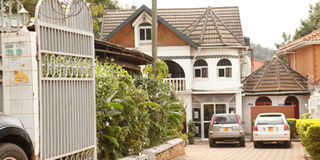How city residential areas are turning into commercial hubs

Changing trends. A former residential building in Bugolobi, a Kampala suburb that now accommodates Nimaro Restaurant. PHOTO BY RACHEL MABALA
What you need to know:
- Changed. Some of the areas that were zoned into residential zones have been converted into business places for bars, guest houses, restaurants and offices.
Kampala.
A new wave of commercialisation is sweeping across Kampala City residential areas where many residential zones are turning into commercial hubs, a trend physical planners say is meant to create more opportunities for Kampala landlords.
Daily Monitor has since established that some of the areas that were zoned into residential zones have been converted into business places for bars, guest houses, restaurants and offices.
Some of these include, high end suburbs of Nakasero, Bukoto, Kololo, Naguru, Acacia and Lumumba avenues. In these places, businesses have since boomed, bringing in a new transition.
During the colonial times and shortly after independence, housing planning in the city was carefully carried out to cater for the different categories of people according to their incomes.
In Kampala, top civil servants lived in places such as Kololo and Naguru; lower level civil servants lived in flats, also in places such as Kololo, while factory workers lived in estates in Naguru, Nakawa and Luzira.
Although these places were considered to be residential areas for first class citizens, they are slowly turning into commercial hubs, offering many opportunities for Kampala residents.
Dr Amin Tamale Kiggundu, a senior lecturer of urban planning at Makerere University, says this trend is being caused by the expansion of the central business district. He says the new urbanisation encourages mixed use of land in the city where human activities can co-exist with human settlement. However, Dr Kiggundu says there must be regulation to control the sprouting businesses to ensure they are in tandem with the physical setting of such areas.
“Kampala has been expanding but we have not embraced vertical development in terms of mixed activities. For instance, in Hong Kong City, which has a high population density, the policy is 301 persons per hectare but in Uganda, it’s only 45 persons per hectare,” he says.
“This isn’t good for us because land is being misused where some people are on rampage of setting up bungalows without considering other activities that they can establish on the same land,” Dr Kiggundu says.
He adds that although the old plan had zoned the city into residential areas, industrial areas, civic areas, administrative, institutions and commercial, the trend has since changed as a result of pressure from growing population.
According to Dr Kiggundu, since the city is now congested in terms of traffic jam, people find it convenient to establish businesses such as restaurants, bars and offices in residential places to avoid the inconveniences downtown.
“Mixed urban development reduces the demand for travel because very many people have now resorted to working from where they stay and there is optimal use of land for both commercial and residential to improve on land management. This explains why you see that people are staying in Kololo and Naguru but have since established businesses there. For those who establish offices in these areas, they want a relaxed environment which is free from the trouble caused by city congestion,” he says.
To make such arrangement effective, Dr Kiggundu says there has to be a regulation to control the activities there so as to have development in line with the planning bodies.
Mr Abdul Mubiru, a bar manager on Acacia Avenue (John Babiiha Avenue) explains that the establishment of businesses in places that were once reserved for residential purposes has been precipitated by the high demand of residents who prefer to have services around their places.
“Majority of these rich people don’t want to be inconvenienced as far as getting services is concerned. That’s why you see that most of these places are expensive because they only accommodate high class people who wouldn’t afford to go downtown to do some shopping,” he says.
In 2013, the Kampala Capital City Authority (KCCA) unveiled the Kampala Physical Development Plan (KPDP). This plan is hinged on 10 planning goals, which should improve the city’s physical planning system.
The goals are to create a multifocal and multifunctional city centre composed of special components of metropolitan importance, to enlarge the central business district, to construct an urban freeway for better accessibility to employment and businesses and to develop the hilltops for public use, recreation and tourism.
Others are to develop Kampala as a lakefront city and to connect the lake to the inner city, to create a new hierarchy of service centres and sub-centres and to stop the linear sprawl of shops and public services, to define and designate new urban quarters and precincts as planning entities for better control, management and development and to encourage new housing models, including affordable housing.




